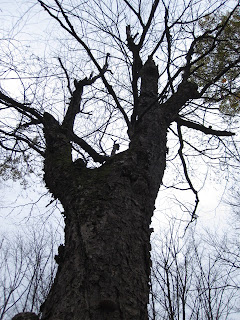This week I was introduced to a tree.
Not just any tree. This tree, which looks like it walked out of the Lord of the Rings’ Middle Earth, is a yellow birch – a bona fide Old Growth yellow birch. And it’s impressive.
It has shed a lot of the crown, over the years, but it was still hanging onto leaves when we walked up to it. Yellow birch are slow-growing long-lived trees mostly found with other hardwoods and conifers on moist well-drained soils. It is an important source of hardwood lumber and a good browse plant for deer and moose. Other wildlife feed on the buds and seeds.
People are often taken aback by how old Old Growth trees can be. I certainly was.
Maturity is normally reached in 120 to 150 years in unmanaged forests. Yellow birch trees are commonly more than 300 years old and occasionally reach ages of more than 366 years. There’s one on record in Algonquin Park that is verified to be 366 years old. Another that is estimated to be over 600 years old. Six hundred... that means when this vast tree was getting started, a tiny twiglet in the Algonquin forest litter, Joan of Arc was being born... Henry V was defeating the French at Agincourt... Dutch fishermen were developing drift nets. It’s astonishing to think of the sweep of history that has marched past while this tree quietly grew in the Canadian Shield.
We don’t know (yet – we’re working on it) how old ‘our’ Old Man of the Forest might be. A little research produced the information that one of the largest specimens on record, near Gould City, MI, is 56.7 inches in diameter at breast height (dbh). The next one cited was 59.5 inches dbh. This one, our Muskoka wonder, is 147" (12' 3) inches on the circumference (we don't know the diameter for sure), which has got us all excited. (Jacquie and I took turns hugging this tree)
It’s a wonder we have any of these trees at all. Mortality of yellow birch seedlings is usually very high, reported to be as high as 97%. And they don’t into the seedling game without due thought to the process: Yellow birches produce seed at about 40 years, with optimum seed production at about 70 years of age. Good seed crops are produced at 1-4 year intervals with limited seed production in the intervening seasons. Seed is disseminated by wind, with most falling after the onset of cold weather. The winged seeds may travel nearly a mile over crusted snow though most end up within an area roughly equivalent to four times the height of the tree. Yellow birch seeds germinate and grow best on moist mineral soil enriched with humus; bare mineral soil and duff alone are unsuitable substrates. However, in undisturbed stands, germination of yellow birch seeds usually occurs on mossy logs, decayed wood, in cracks in boulders and on windthrown tree hummocks. Optimum germination of yellow birch occurs at 59 to 61 degrees Fahrenheit (15-16 deg C). Seedlings require overhead light, crown expansion space, and plentiful soil moisture and nutrients to compete with faster growing associates; conditions found in gaps are conducive to yellow birch seedling establishment. Some shade improves seedling survival. Too much shade has the opposite effect.
This is certainly the biggest, gnarliest yellow birch I have ever seen. It could well be over 300 years old. It is quite possible that it was growing while Shakespeare was penning Romeo and Juliet, or Henry V. It is scarred, twisted, decorated by fungus and missing large bits of the crown, but it is still here. Still wearing leaves. Still watching the forest. Still standing.
That counts for something.
Subscribe to:
Post Comments (Atom)
















No comments:
Post a Comment